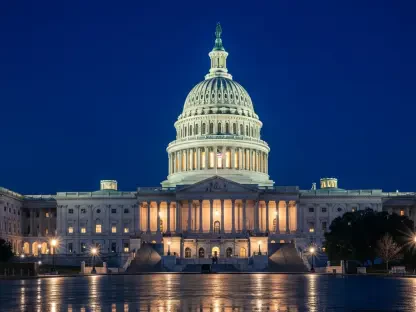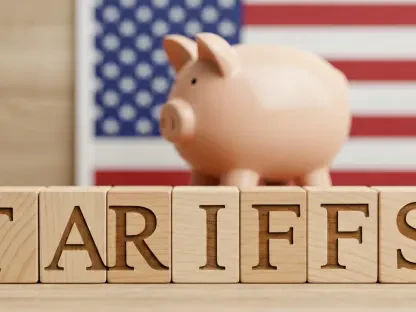Imagine a government in gridlock, where thousands of federal workers face the threat of permanent job loss during a funding lapse, while courtrooms stall under the weight of furloughed attorneys. This chaotic scenario is the reality for many in the federal workforce as the Trump administration aggressively pursues layoffs amid a shutdown. The clash of policy, law, and operational dysfunction has sparked heated debates across political, legal, and labor circles. This roundup gathers diverse opinions, insights, and analyses from various stakeholders—unions, policy analysts, legal advocates, and government insiders—to unpack the motivations, challenges, and implications of these actions. The aim is to provide a comprehensive view of this unfolding crisis and its impact on federal employees and governance.
Unpacking the Layoff Push: Diverse Opinions on Context and Urgency
The current government shutdown has become a flashpoint for the Trump administration’s push for workforce reductions, often termed “reductions in force” (RIFs). Many policy analysts argue that the administration’s stance reflects a long-standing goal of shrinking federal agencies, now amplified by the funding crisis. They point to statements from budget officials framing layoffs as essential for cost-saving, suggesting that permanent cuts could streamline operations even during temporary lapses.
On the other hand, labor advocates counter that this approach exploits a manufactured crisis. They emphasize that shutdowns historically rely on furloughs, not permanent job cuts, raising doubts about the urgency and necessity of such drastic measures. Their perspective highlights a deeper concern about the erosion of job security for federal workers already grappling with uncertainty.
A third viewpoint comes from government insiders who note the operational chaos caused by these decisions. With essential services disrupted, some argue that layoffs risk further destabilizing agencies at a critical time. This diversity of opinion underscores the complexity of balancing fiscal priorities with workforce stability, setting the stage for deeper exploration of specific dimensions of the crisis.
Diving into the Crisis: Key Dimensions and Disputes
Shutdown as a Trigger: Why Layoffs at This Moment?
The timing of layoffs during a shutdown has drawn sharp scrutiny from various corners. Budget hawks within government circles defend the move, asserting that reducing staff numbers is a pragmatic response to constrained resources. They argue that agencies must adapt to financial realities, citing examples like the U.S. Patent and Trademark Office’s recent 1% workforce cut as a necessary, albeit small, step toward efficiency.
Labor unions, however, see this rationale as a thinly veiled attempt to bypass accountability. Their position is that linking permanent layoffs to a temporary funding issue lacks logical grounding, especially when furloughs have long been the standard response. They warn that such actions could set a dangerous precedent for exploiting crises to push unrelated agendas.
Policy researchers add another layer, questioning whether cost-saving claims hold up under scrutiny. They suggest that the long-term impact of losing skilled workers may outweigh short-term financial gains, particularly in specialized agencies. This debate reveals a stark divide between immediate fiscal goals and sustainable governance.
Legal Pushback: Federal Workers and Advocates Respond
Legal resistance to the layoffs has emerged as a powerful counterforce, with multiple groups weighing in on the fight. Federal employee unions describe the administration’s actions as a direct assault on worker rights, emphasizing active lawsuits against agencies like the Education Department. They argue that these legal challenges are crucial to preserving protections for thousands of employees.
Advocacy organizations echo this sentiment, focusing on the broader implications of executive overreach. Their stance is that unchecked layoffs during a shutdown could redefine the boundaries of governmental authority, especially if courts fail to intervene. They highlight a sweeping lawsuit targeting 25 agencies as evidence of widespread concern over fairness and legality.
State-level officials also contribute to the discussion, often aligning with unions to challenge federal actions in court. Their perspective centers on the potential ripple effects on local economies if federal workers lose jobs en masse. Together, these voices paint a picture of a robust, multi-front battle to safeguard employee rights amid crisis.
Operational Gridlock: Shutdown Delays Justice
The shutdown’s impact on legal proceedings has frustrated many stakeholders, with differing views on its consequences. Government representatives claim that delays in court cases, driven by furloughed Justice Department attorneys, are an unavoidable logistical issue. They point to blanket stays on civil proceedings, such as in the U.S. Court for the District of Columbia, as necessary under current constraints.
Legal advocates, however, suspect a strategic motive behind these delays. Their analysis suggests that stalling lawsuits might shield the administration from immediate scrutiny, buying time to advance controversial policies. They argue that justice delayed risks becoming justice denied for affected workers awaiting rulings.
Judicial observers offer a more neutral take, noting that procedural paralysis affects all parties, not just the government. They highlight pending decisions on administrative pauses as a critical factor in determining how quickly accountability can be enforced. This mix of opinions reveals the shutdown’s far-reaching disruption of legal oversight.
Political Motives: Ideology Driving the Layoff Agenda
The political undercurrents of the layoff push have sparked intense commentary from various angles. Conservative commentators align with the administration’s rhetoric, which often labels certain agencies as inefficient or politically biased. They view shutdowns as a chance to reshape federal structures, applauding efforts to reduce what they see as bloated bureaucracies.
Progressive analysts sharply disagree, arguing that ideological goals are trumping economic reasoning. They reference past workforce cuts at places like the Interior Department to suggest that current actions are part of a broader anti-government agenda, risking long-term damage to institutional capacity. Their concern is the potential hollowing out of public services.
Academic policy experts provide a balanced perspective, cautioning against prioritizing political wins over workforce stability. They warn that sustained ideological battles could undermine trust in federal systems, creating challenges for future administrations. This spectrum of thought illustrates how deeply politics shapes the layoff narrative.
Lessons and Takeaways from the Layoff-Shutdown Conflict
Examining the clash over layoffs during the shutdown reveals critical insights from a range of sources. Labor leaders stress the resilience of federal workers despite mounting pressures, urging stronger coalitions to amplify their voice in legal and political arenas. Their input highlights the human toll of policy decisions often debated in abstract terms.
Policy advisors, meanwhile, call for clearer emergency funding mechanisms to prevent similar crises from escalating. They argue that partisan gridlock must give way to practical solutions, ensuring that shutdowns don’t become tools for workforce reduction. This perspective focuses on systemic reforms to protect government functionality.
Legal analysts add that the ongoing battles could redefine executive limits during national emergencies. They suggest that outcomes of current lawsuits might establish lasting precedents, influencing how future administrations handle crises. These varied lessons underscore the need for vigilance and collaboration among stakeholders navigating this turbulent landscape.
Reflecting on the Ripple Effects of the Layoff Strategy
Looking back, the intense debate surrounding the Trump administration’s layoff push during the shutdown captured a pivotal moment of tension between executive action and systemic resistance. The diverse opinions from unions, legal advocates, policy experts, and government insiders illuminated the multifaceted stakes for federal workers and governance as a whole. Moving forward, stakeholders can take actionable steps by closely monitoring legal outcomes and advocating for robust protections through coalition-building. Additionally, exploring resources on federal employee rights and staying updated on funding legislation can empower affected communities. This crisis served as a stark reminder of the need for balanced policies that prioritize both fiscal responsibility and workforce stability, offering a foundation for future reforms.









